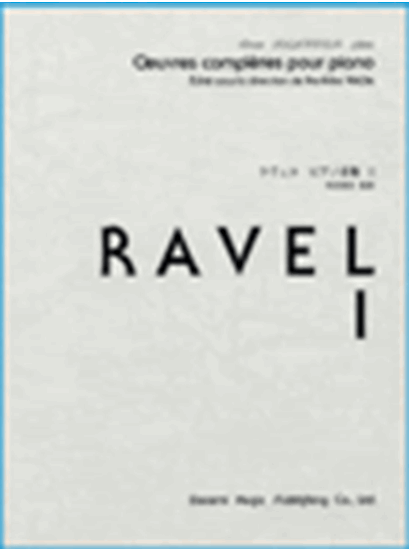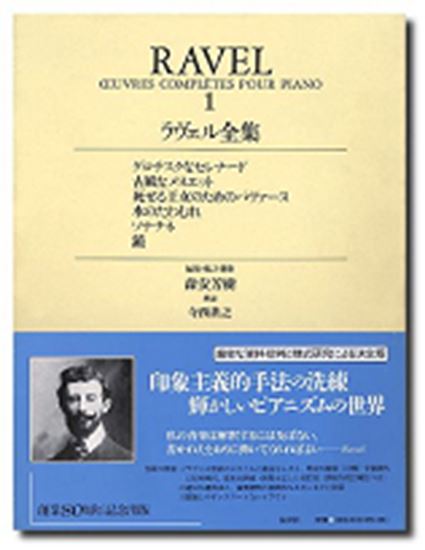Ravel, Maurice : Miroirs "Alborada del gracioso" d-moll
Work Overview
Genre:character pieces
Total Playing Time:6 min 30 sec
Copyright:Public Domain
Commentary (2)
Author : Tachi, Arisa
Last Updated: February 13, 2019
[Open]
Author : Tachi, Arisa
No. 4: Alborada del gracioso
Dedicated to the music writer Michael Dimitri Calvocoressi (1877–1944). Among the five pieces, this one is somewhat distinct, with its dance-like character prominently featured. Ravel, who had Basque ancestry, held a strong interest in Spain and left many works inspired by the country, such as the opera L'heure espagnole and the orchestral work Rapsodie espagnole. However, Alborada del gracioso is not merely a “Spanish-style” piece; it also reveals Ravel's keen sensitivity to harmony and rhythm.
The entire piece is in a clear three-part form, contrasting an A section where decorative and melodic figures are inserted into chords that strictly mark the tempo, with a B section where dance-like fragments are inserted into a broadly sung melody that, conversely, fluctuates in tempo. The opening of the piece features a Phrygian mode based on D, with added F# and C#. However, the tonality is ambiguous because F# can be interpreted as either a scale degree or an ornamental note, and C# does not function as a leading tone. As the tonic shifts from D to B♭ to D♭, major triads sound as tonic chords, and upon entering measure 43, a V–I progression in C-sharp minor is presented, clarifying the tonality. The A section then concludes brilliantly with a cadenza in D major. The beginning of the B section also starts with a declamatory melody in D major, extending from the previous section. However, each time a chord is inserted, the leading-tone function of C# weakens (or the sharp frequently drops from C), and the music develops an enchanting atmosphere, oscillating between major and minor modes with B as the tonic. Within this, a syncopated rhythm appearing in the right hand, blurring the metric divisions, is contrasted with the impetuous movement of the left hand, reminiscent of dance steps. In the A' section, the tonic shifts from E♭ to F#, leading the listener to expect a cadenza in F-sharp minor. However, contrary to this expectation, measure 175 presents a progression of C#→B♭/A/G, and the music continues to shift tonics while maintaining an ambiguous tonality, finally returning to A (the dominant of D) → D (as at the beginning) in the coda from measure 200 onwards. Finally, the D major tonic chord is played resoundingly, and the piece concludes brilliantly.
Author : Tachi, Arisa
Last Updated: July 17, 2019
[Open]
Author : Tachi, Arisa
Dedicated to the music writer M. D. Calvocoressi (1877-1944). Among the five pieces, it stands out somewhat, with its dance-like character prominently featured. Ravel, who had Basque ancestry, held a strong interest in Spain, leaving behind many works that evoke the country, such as the opera L'heure espagnole and the orchestral work Rapsodie espagnole. However, "Alborada del gracioso" is not merely a "Spanish-style" piece; it also reveals Ravel's keen sensitivity to harmony and rhythm.
The piece as a whole is in a clear ternary form, contrasting an A section, where decorative and melodic figures are inserted into chords that strictly mark the tempo, with a B section, where dance-like fragments are inserted into a broadly sung melody that, conversely, fluctuates in tempo. The opening of the piece features a Phrygian mode based on D, with F# and C# added. However, the tonality remains ambiguous, as F# can be interpreted as either a scale degree or an ornamental note, and C# does not function as a leading tone. Yet, as the fundamental note shifts from D to B♭ to D♭, major triads sound as tonic chords, and upon entering measure 43, a V-I progression in C-sharp minor is presented, clarifying the tonality. The A section then concludes brilliantly with a cadenza in D major. The beginning of the B section also starts with a declamatory melody in D major, extending from the previous section. However, with each inserted chord, the function of C# as a leading tone weakens (or the sharp frequently drops from C), and the music takes on an enchanting atmosphere, oscillating between major and minor modes with B as the fundamental note. Within this, a syncopated rhythm in the right hand, which blurs the metrical divisions, is contrasted with the urgent movements in the left hand, reminiscent of dance steps. In the A' section, the fundamental note shifts from E♭ to F#, leading the listener to expect a cadence in F-sharp minor. However, contrary to this expectation, measure 175 presents a progression of C#→B♭/A/G, and the music continues to shift its fundamental notes one after another while maintaining an ambiguous tonality. Only in the coda, from measure 200 onwards, does it finally return to A (the dominant of D) → D (as at the beginning). Finally, the tonic chord of D major is played resoundingly, bringing the piece to a brilliant conclusion.
PTNA & Partner Channel Videos(12items) View More
- favorite_border
- 0
Recording Date: 2019/8/20
Recording Location: 第一生命ホール(2019年ピティナ・ピアノコンペティション G級全国決勝大会)
- favorite_border
- 0
Recording Date: 2023/2/18
Recording Location: 王子ホール(第46回コンペ全国大会グランミューズ入賞者記念コンサート)
Sheet Music
Scores List (7)

(株)ヤマハミュージックエンタテインメントホールディングス

(株)音楽之友社

(株)ドレミ楽譜出版社

(株)全音楽譜出版社

(株)ドレミ楽譜出版社

(株)全音楽譜出版社

(株)春秋社













